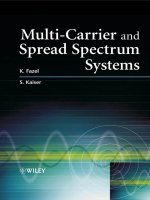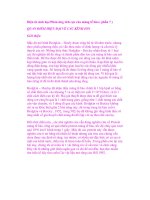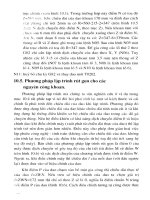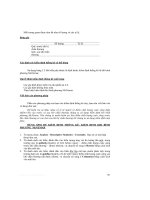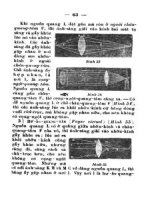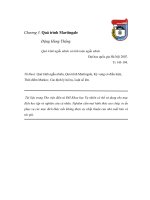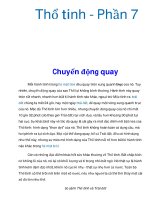Multi carrier and spread spectrum systems phần 7 ppsx
Bạn đang xem bản rút gọn của tài liệu. Xem và tải ngay bản đầy đủ của tài liệu tại đây (264.53 KB, 30 trang )
162 Implementation Issues
coding, the systematic structure of the RS code allows one to shorten the code, i.e.,
remove the filled 239 − K zero bytes before transmission. Then, each coded packet
of length K + 16 bytes will be serial bit converted.
— At the end of the each packet, tailbits (e.g., 6 bits for memory 6) can be inserted for
inner code trellis termination purposes.
— A block consisting of [(K + 16) × 8 +6] bits is encoded by the inner convolutional
mother binary code of rate 1/2. After convolutional coding, the puncturing operation
is applied following the used inner code rate R for the given packet. This results in
a total of [(K +16) × 8 + 6]/R bits. Finally, the punctured bits are serial-to-parallel
converted and submitted to the symbol mapper.
If the BER before RS decoding is guaranteed to be about 2 ·10
−4
, then with sufficient
interleaving (e.g., 8 RS code words) for the same SNR values given in Table 4-3, a quasi
error-free (i.e., BER < 10
−12
) transmission after RS decoding is guaranteed. However, if
no interleaving is employed, depending on the inner coding rate, a loss of about 1.5–2.5
dB has to be considered to achieve a quasi error-free transmission [20].
4.4.3 Turbo Coding
Recently, interest has focused on iterative decoding of parallel or serial concatenated
codes using soft-in/soft-out (SISO) decoders with simple code components in an inter-
leaved scheme [4][28][29][30][66]. These codes, after several iterations, provide near-
Shannon performance [29][30]. We will consider here two classes of codes with iterative
decoding: convolutional and block Turbo codes. These codes are already adopted in
several standards.
4.4.3.1 Convolutional Turbo Coding
By applying systematic recursive convolutional codes in an iterative scheme and by intro-
ducing an interleaver between the two parallel encoders, impressive results can be obtained
with so-called convolutional Turbo codes [4]. Convolutional Turbo codes are currently of
great interest because of their good performance at low SNRs.
Figure 4-38 shows the block diagram of a convolutional Turbo encoder. The code struc-
ture consists of two parallel recursive systematic punctured convolutional codes. A block
of encoded bits consists of three parts. The two parity bit parts and the systematic part
which is the same in both code bit streams and, hence, has to be transmitted only once.
The code bit sequence at the output of the Turbo encoder is given by the vector b
(k)
.
a
(k)
b
(k)
convolutional
encoder
convolutional
encoder
puncturing
puncturing
interleaver
Figure 4-38 Convolutional Turbo encoder
Channel Coding and Decoding 163
deinterleaver
deinterleaver
interleaver
convolutional
decoder
convolutional
decoder
interleaver
sign(.)‘0’ insertion
‘0’ insertion
l
(k)
a
^(k)
Figure 4-39 Convolutional Turbo decoder
In the receiver, the decoding is performed iteratively. Figure 4-39 shows the block
diagram of the convolutional Turbo decoder. The component decoders are soft output
decoders providing log-likelihood ratios (LLRs) of the decoded bits (see Section 2.1.7).
The basic idea of iterative decoding is to feed forward/backward the soft decoder output
in the form of LLRs, improving the next decoding step. In the initial stage, the non-
interleaved part of the coded bits b
(k)
is decoded. Only the LLRs given by the vector l
(k)
at the input of the Turbo decoder are used. In the second stage, the interleaved part is
decoded. In addition to the LLRs given by l
(k)
, the decoder uses the output of the first
decoding step as apriori information about the coded bits. This is possible due to the
separation of the two codes by the interleaver. In the next iteration cycle, this procedure is
repeated, but now the non-interleaved part can be decoded using an apriori information
delivered from the last decoding step. Hence, this decoding run has a better performance
than the first one and the decoding improves. Since in each individual decoding step the
decoder combines soft information from different sources, the representation of the soft
information is crucial.
It is shown in [29] and [30] that the soft value at the decoder input should be a LLR
to guarantee that after combining the soft information at the input of the decoder LLRs
are again available. The size of the Turbo code interleaver and the number of iterations
essentially determine the performance of the Turbo coding scheme.
The performance of Turbo codes as channel codes in different multi-carrier multi-
ple access schemes is analyzed for the following Turbo coding scheme. The component
codes of the Turbo code are recursive systematic punctured convolutional codes, each
of rate 2/3, resulting in an overall Turbo code rate of R = 1/2. Since performance with
Turbo codes in fading channels cannot be improved with a memory greater than 2 for
a BER of 10
−3
[30], we consider a convolutional Turbo code with memory 2 in order
to minimize the computational complexity. The component decoders exploit the soft
output Viterbi algorithm (SOVA) [28]. The Turbo code interleaver is implemented as a
random interleaver. Iterative Turbo decoding in the channel decoder uses 10 iterations.
The SNR gain with Turbo codes relative to convolutional codes with R = 1/2and
memory 6 versus the Turbo code interleaver size I
TC
is given in Figure 4-40 for the
BER of 10
−3
.
164 Implementation Issues
OFDM (OFDMA, MC-TDMA)
MC-CDMA, MLSE/MLSSE
MC-CDMA, MMSE equalizer
100
0.0
0.5
1.0
1.5
2.0
1000 10000
Turbo code interleaver size
SNR gain in dB
Figure 4-40 SNR gain with Turbo codes relative to convolutional codes versus interleaver size
I
TC
The results show that OFDMA and MC-TDMA systems benefit more from the applica-
tion of Turbo codes than MC-CDMA systems. It can be observed that the improvements
with Turbo codes at interleaver sizes smaller than 1000 are small.
Due to the large interleaver sizes required for convolutional Turbo codes, they are of
special interest for non-real time applications.
4.4.3.2 Block Turbo Coding
The idea of product block or block Turbo coding is to use the well-known product codes
with block codes as components for two-dimensional coding (or three dimensions) [66].
The two-dimensional code is depicted in Figure 4-41. The k
r
information bits in the rows
are encoded into n
r
bits, by using a binary block code C
r
(n
r
,k
r
). The redundancy of the
code is r
r
= n
r
− k
r
and d
r
the minimum distance. After encoding the rows, the columns
are encoded using another block code C
c
(n
c
,k
c
), where the check bits of the first code
are also encoded.
The two-dimensional code has the following characteristics
— overall block size n = n
r
· n
c
,
— number of information bits k
r
· k
c
,
— code rate R = R
r
· R
c
,whereR
i
= k
i
/n
i
, i = c, r,and
— minimum distance d
min
= d
r
· d
c
.
The binary block codes employed for rows and columns could be systematic BCH
(Bose–Chaudhuri–Hocquenghem) or Hamming codes [48]. Furthermore, the constituent
Channel Coding and Decoding 165
Data bits
Parity bits
Parity
bits
k
r
n
r
n
c
k
c
Figure 4-41 Two-dimensional product code matrix
Tabl e 4-4 Generator polynomials of
Hamming codes as block Turbo code
components
n
i
k
i
Generator
7 4 x
3
+ x +1
15 11 x
4
+ x +1
31 26 x
5
+ x
2
+ 1
63 57 x
6
+ x +1
127 120 x
7
+ x
3
+ 1
codes of rows or columns can be extended with an extra parity bit to obtain extended
BCH or Hamming codes. Table 4-4 gives the generator polynomials of the Hamming
codesusedinblockTurbocodes.
The main advantage of block Turbo codes is in their application for packet transmis-
sion, where the interleaver as it is used in convolutional Turbo coding is not necessary.
Furthermore, as block codes, block Turbo codes are efficient for high code rates.
To match packet sizes, a product code can be shortened by removing symbols. In the
two-dimensional case, either rows or columns can be removed until the appropriate size
is reached. Unlike one-dimensional codes (such as Reed–Solomon codes), parity bits are
removed as part of the shortening process, helping to keep the code rate high.
As with convolutional Turbo codes, the decoding of block Turbo codes is done in an
iterative way [66]. First, all the horizontal blocks are decoded then all the vertical received
blocks are decoded (or vice versa). The decoding procedure is iterated several times to
maximize the decoder performance. The core of the decoding process is the soft-in/soft-
out (SISO) constituent code decoder. High-performance iterative decoding requires the
constituent code decoders to not only determine a transmitted sequence, but also to yield
a soft decision metric (i.e., LLR) which is a measure of the likelihood or confidence of
each bit in that sequence. Since most algebraic block decoders do not operate with soft
166 Implementation Issues
Tabl e 4-5 Performance of block Turbo codes in AWGN channel after three iterations
BTC constituent codes Coded packet size Code rate E
b
/N
0
at
BER = 10
−9
(23,17)(31,25) 53 bytes 0.596 4.5 dB
(16,15)(64,57) 106 bytes 0.834 6.2 dB
(56,49)(32,26) 159 bytes 0.711 3.8 dB
(49,42)(32,31) 159 bytes 0.827 6.5 dB
(43,42)(32,31) 159 bytes 0.945 8.5 dB
inputs or generate soft outputs, such block decoders have primarily been used using the
soft output Viterbi algorithm (SOVA) [28] or a soft output variant of the modified Chase
algorithm(s) [6]. However, other SISO block decoding algorithms can also be used for
deriving the LLR.
The decoding structure of block Turbo codes is similar to that of Figure 4-39, where
instead of convolutional decoders, the row and column decoders are applied. Note that
here the interleaving is simply a read/write mechanism of rows and columns of the code
matrix. The performance of block Turbo codes with three iterations for different packet
sizes in an AWGN channel is given in Table 4-5.
4.4.4 OFDM with Code Division Multiplexing: OFDM-CDM
OFDM-CDM is a multiplexing scheme which can better exploit diversity than conven-
tional OFDM systems. Each data symbol is spread over several sub-carriers and/or several
OFDM symbols, exploiting additional frequency- and/or time-diversity [36][37]. By using
orthogonal spreading codes, self-interference between data symbols can be minimized.
Nevertheless, self-interference occurs in fading channels due to a loss of orthogonality
between the spreading codes. To reduce this degradation, an efficient data detection and
decoding technique is required. The principle of OFDM-CDM is shown in Figure 4-42.
data
source
channel
decoder
channel
deinter-
leaver
deinter-
leaver
IOFDM
symbol
demapper
channel
encoder
inter-
leaver
inter-
leaver
OFDM
symbol
mapper
spreader
(HT)
detector
(IHT)
CSICSI
CDM
data
sink
Figure 4-42 OFDM-CDM transmitter and receiver
Signal Constellation, Mapping, Demapping, and Equalization 167
123
10
−5
10
−4
10
−3
10
−2
10
−1
10
0
4
BER
5
E
b
/N
0
in dB
678
OFDM-CDM, CC
OFDM, CC
OFDM, TC, I = 256
OFDM, TC, I = 1024
Figure 4-43 Performance of OFDM-CDM with classical convolutional codes versus OFDM with
Turbo codes and interleaver size 256 and 1024, respectively
MC-CDMA and SS-MC-MA can be considered special cases of OFDM-CDM. In MC-
CDMA, CDM is applied for user separation and in SS-MC-MA different CDM blocks of
spread symbols are assigned to different users.
The OFDM-CDM receiver applies single-symbol detection or more complex multi-
symbol detection techniques which correspond to single-user or multiuser detection tech-
niques, respectively, in the case of MC-CDMA. The reader is referred to Section 2.1.5
for a description of the different detection techniques.
In Figure 4-43, the performance of OFDM-CDM using classical convolutional codes is
compared with the performance of OFDM using Turbo codes. The BER versus the SNR
for code rate 1/2 and QPSK symbol mapping is shown. Results are given for OFDM-
CDM with soft IC after the 1st iteration and for OFDM using Turbo codes with interleaver
sizes I = 256 and I = 1024 and iterative decoding with 10 iterations. As reference, the
performance of OFDM with classical convolutional codes is given. It can be observed
that OFDM-CDM with soft IC and classical convolutional codes can outperform OFDM
with Turbo codes.
4.5 Signal Constellation, Mapping, Demapping, and Equalization
4.5.1 Signal Constellation and Mapping
The modulation employed in multi-carrier systems is usually based on quadrature ampli-
tude modulation (QAM) with 2
m
constellation points, where m is the number of bits
transmitted per modulated symbol, and M = 2
m
is the number of constellation points.
The general principle of modulation schemes is illustrated in Figure 4-44, which is valid
for both uplink and downlink.
168 Implementation Issues
From encoder
(serial bits)
S/P
2
m
QAM-
Mapping
•
•
b
0
b
m −1
I
Q
K
Mod
K
Mod
Figure 4-44 Signal mapping block diagram
Tabl e 4-6 Bit mapping with 4-QAM
b
0
b
1
I Q
0 0 1 1
0 1 1 −1
1 0 −1 1
1 1 −1 −1
For the downlink, high-order modulation can be used such as 4-QAM (m = 2) up to 64-
QAM (m = 6). For the uplink, more robust 4-QAM is preferred. Typically, constellation
mappings are based on Gray mapping, where adjacent constellation points differ by only
one bit.
Table 4-6 defines the constellation for 4-QAM modulation. In this table, b
l
,l =
0, ,m− 1, denotes the modulation bit order after serial to parallel conversion.
The complex modulated symbol takes the value I + jQ from the 2
m
point constellation
(see Figure 4-45). In the case of transmission of mixed constellations in the downlink
frame, i.e., adaptive modulation (from 4-QAM up to 64-QAM), a constant RMS should
be guaranteed. Unlike the uplink transmission, this would provide the advantage that the
downlink interference from all base stations has a quasi-constant behavior. Therefore,
the output complex values are formed by multiplying the resulting I +jQ value by a
normalization factor K
MOD
as shown in Figure 4-44. The normalization K
MOD
depends
on the modulation as prescribed in Table 4-7.
Symbol mapping can also be performed differentially as with D-QPSK applied in the
DAB standard [14]. Differential modulation avoids the necessity of estimating the carrier
phase. Instead, the received signal is compared to the phase of the preceding symbol [65].
However, since one wrong decision results in 2 decision errors, differential modulation
performs worse than non-differential modulation with accurate knowledge of the channel
in the receiver. Differential demodulation can be improved by applying a two-dimensional
demodulation, where the correlation of the channel in time and frequency direction is taken
into account in the demodulation [27].
Signal Constellation, Mapping, Demapping, and Equalization 169
00
Q
I
10
01
b
0
b
1
b
0
b
1
b
2
b
3
b
4
b
5
1−1
−1
1
11
001011 000011 010011 011011
001010 000010 010010 011010
001000 000000 010000 011000
001001 000001 010001 011001 I
111011 110011 100011 101011
−7
−5
−3
−1
1
3
5
7
Q
111010 110010 100010 101010
111000 110000 100000 101000
111001 110001 100001 101001
111101 110101 100101 101101
111100 110100 100100 101100
111110 110110 100110 101110
111111
0001
Q
0101
0000 0100
1101 1001
1100 1000
13
I
−3 −1
−1
−3
1
3
0010 0110
0011
b
0
b
1
b
2
b
3
0111
1110 1010
1111 1011
110111 100111 101111
001101 000101 010101 011101
−7 −5 −3 −11357
001100 000100 010100 011100
001110 000110 010110 011110
001111 000111 010111 011111
Figure 4-45 M-QAM signal constellation
Tabl e 4-7 Modulation dependent
normalization factor K
MOD
Modulation K
MOD
4-QAM 1
16-QAM 1/
√
5
64-QAM 1/
√
21
4.5.2 Equalization and Demapping
The channel estimation unit in the receiver provides for each sub-carrier n an esti-
mate of the channel transfer function H
n
= a
n
e
jϕ
n
. In mobile communications, each
sub-carrier is attenuated (or amplified) by a Rayleigh or Ricean distributed variable
a
n
=|H
n
| and phase distorted by ϕ
n
. Therefore, after FFT operation a correction of
the amplitude and the phase of each sub-carrier is required. This can be done by a
simple channel inversion, i.e., multiplying each sub-carrier by 1/H
n
. Since each sub-
carrier suffers also from noise, this channel correction for small values of a
n
leads
to a noise amplification. To counteract this effect, the SNR value γ
n
= 4|H
n
|
2
/σ
2
n
of
each sub-carrier (where σ
2
n
is the noise variance at sub-carrier n) should be consid-
ered for soft metric estimation. Moreover, in order to provide soft information for the
channel decoder, i.e., Viterbi decoder, the received channel corrected data (after FFT
170 Implementation Issues
•
•
•
•
•
•
FFT
1/H
0
1/H
1
g
1
g
0
Reliability
estimation
Reliability
estimation
Quantization
Quantization
P/S
1/H
Nc−1
g
Nc−1
Reliability
estimation
Quantization
To decoder
Equalization De-mapping and soft metric derivation
Figure 4-46 Channel equalization and soft metric derivation
and equalization with CSI coefficients) should be optimally converted to soft metric
information. Thus, the channel-corrected data have to be combined with the reliability
information exploitary channel state information for each sub-carrier, so that each encoded
bit has an associated soft metric value and a hard decision that are provided to the Viterbi
decoder.
As shown in Figure 4-46, after channel correction, i.e., equalization, for each mapped
bit of the constellation a reliability information is provided. This reliability information
corresponds to the minimum distance from the nearest decision boundary that affects the
decision of the current bit. This metric corresponds to LLR values (see Section 2.1.7) [65]
after it is multiplied with the corresponding value of the SNR of each sub-carrier γ
n
=
4|H
n
|
2
/σ
2
n
. Finally after quantization (typically 3–4 bits for amplitude and 1 bit for the
sign), these soft values are submitted to the channel decoder.
4.6 Adaptive Techniques in Multi-Carrier Transmission
As shown in Chapter 1, the radio channel suffers especially from time and frequency
selectivity. Co-channel and adjacent channel interference (CCI and ACI) are further
impairments that are present in cellular environments due to the high frequency reuse.
Each terminal station may have different channel conditions. For instance, the terminal
stations located near the base station receive the highest power which results in a high
carrier-to-noise and -interference power ratio C/(N + I). However, the terminal station
at the cell border has a lower C/(N + I).
In order to exploit the channel characteristics and to use the spectrum in an effi-
cient way, several adaptive techniques can be applied, namely adaptive FEC, adap-
tive modulation, and adaptive power leveling. Note that the criteria for these adaptive
Adaptive Techniques in Multi-Carrier Transmission 171
techniques can be based on the measured C/(N + I) or the received average power
per symbol or per sub-carrier. These measured data have to be communicated to the
transmitter via a return channel, which may be seen as a disadvantage for any adap-
tive techniques.
In TDD systems this disadvantage can be reduced, since the channel coefficients are
typically highly correlated between successive uplink and downlink slots and, thus, are
also available at the transmitter. Only if significant interference occurs at the receiver,
this has to be communicated to the transmitter via a return channel.
4.6.1 Nulling of Weak Sub-Carriers
The most straightforward solution for reducing the effect of noise amplification during
equalization is the technique of nulling weak sub-carriers which can be applied in an
adaptive way. Sub-carriers with the weakest received power are discarded at the trans-
mission side. However, by using strong channel coding or long spreading codes, the gain
obtained by nulling weak sub-carriers is reduced.
4.6.2 Adaptive Channel Coding and Modulation
Adaptive coding and modulation in conjunction with multi-carrier transmission can be
applied in several ways. The most commonly used method is to adapt channel coding and
modulation during each transmit OFDM frame/burst, assigned to a given terminal sta-
tion [16][17][18]. The most efficient coding and modulation will be used for the terminal
station having the highest C/(N +I), where the most robust one will be applied for the
terminal station having the worst C/(N + I) (see Figure 4-47). The spectral efficiency in
a cellular environment is doubled using this adaptive technique [20].
An alternative technique that can be used in multi-carrier transmission is to apply the
most efficient modulation for sub-carriers with the highest received power, where the
most robust modulation is applied for sub-carriers suffering from multipath fading (see
Figure 4-48).
Furthermore, this technique can be applied in combination with power control to reduce
out of band emission, where for sub-carriers located at the channel bandwidth border
low-order modulation with low transmit power and for sub-carriers in the middle of the
bandwidth higher order modulation with higher power can be used.
BS
TS
1
TS
2
TS
3
OFDM symbols up to 16-QAM mod.
OFDM symbols up to 64-QAM mod.
to TS
2
to TS
1
OFDM symbols with 4-QAM mod.
to TS
3
d
1
d
3
d
2
d
3
> d
2
> d
1
Figure 4-47 Adaptive channel coding and modulation per OFDM symbol
172 Implementation Issues
Frequency
Received power
4-QAM
16-QAM
64-QAM
Figure 4-48 Adaptive channel coding and modulation per sub-carrier
4.6.3 Adaptive Power Control
Beside the adaptation of coding and modulation, the transmit power of each OFDM sym-
bol or each sub-carrier can be adjusted to counteract, for instance, the near–far problem
or shadowing. A combination of adaptive coding and modulation (the first approach) with
power adjustment per OFDM symbol is usually adopted [17][18].
4.7 RF Issues
A simplified OFDM transmitter front-end is illustrated in Figure 4-49. The transmitter
comprises an I/Q generator with a local oscillator with carrier frequency f
c
,low-pass
filters, a mixer, channel pass-band filters, and a power amplifier. After power amplification
and filtering, the RF analog signal is submitted to the transmit antenna. The receiver
front-end comprises similar components.
Especially in cellular environments due to employing low gain antennas, i.e., non-
directive antennas, high-power amplifiers are needed to guarantee a given coverage and
Local
oscillator
f
c
Filter
(low pass)
D/A
N
c
-Point
IDFT
(complex
domain)
cos(.)
sin(.)
I
Q
+
D/A
Filter
(pass band)
Filter
(low pass)
High
power
amplifier
Filter
(pass band)
Figure 4-49 Simplified OFDM transmitter front end
RF Issues 173
hence reduce, for instance, infrastructure costs by installing fewer base stations. Unfor-
tunately, high power amplifiers are non-linear devices, where the maximum efficiency is
achieved at saturation point.
Furthermore, at high carrier frequencies (e.g., HIPERLAN/2 at 5 GHz) low cost
RF transmit and receive oscillators can be applied at the expense of higher phase
noise.
The main objective of this section is to analyze the performance of multi-carrier and
multi-carrier CDMA transmission with a high number of sub-carriers in the presence of
low cost oscillators with phase noise and HPAs with both AM/AM and AM/PM non-
linear conversions. First, a commonly accepted phase noise model is described. After
analyzing its effects in multi-carrier transmission with high order modulation, measures
in the digital domain based on common phase error (CPE) correction are discussed. The
effects of two classes of non-linear power amplifiers are presented, namely traveling
wave tube amplifiers (TWTAs) and solid state power amplifiers (SSPAs). Two techniques
based on pre-distortion and spreading code selection are discussed. Finally, in order to
estimate the required transmit RF power for a given coverage area, a link budget analysis
is carried out.
4.7.1 Phase Noise
The performance of multi-carrier synchronization tracking loops depends strongly on the
RF oscillator phase noise characteristics. Phase noise instabilities can be expressed and
measured in the time and/or frequency domain.
4.7.1.1 Phase Noise Modeling
Various phase noise models exist for the analysis of phase noise effects. Two often
used phase noise models which assume instability of the phase only are described in
the following.
Lorenzian Power Density Spectrum
The phase noise generated by the oscillators can be modeled by a Wiener–L
`
evy pro-
cess [63], i.e.,
θ(t) = 2π
t
0
µ(τ) dτ, (4.73)
where µ(τ) represents white Gaussian frequency noise with power spectral density N
0
.
The resulting power density spectrum is Lorenzian, i.e.,
H(f) =
2
πβ +
2πf
β
2
.(4.74)
The two-sided 3 dB bandwidth of the Lorenzian power density spectrum is given by β,
also referred to as the line-width of the oscillator.
174 Implementation Issues
Measurement Based Power Density Spectrum
An approach used within the standardization of DVB-T is the application of the power
density spectrum defined by [69]
H(f) = 10
−c
+
10
−a
|f | f
1
10
b(f
1
−f )/(f
2
−f
1
)−a
f>f
1
10
b(f
1
+f )/(f
2
−f
1
)−a
f<−f
1
(4.75)
The parameters a and f
1
characterize the phase lock loop (PLL) and the parameter c the
noise floor. The steepness of the linear slope is given by b and the frequency f
2
indicates
where the noise floor becomes dominant. A plot of the power density spectrum with
typical parameters (a = 6.5, b = 4, c = 10.5, f
1
= 1kHz,andf
2
= 10 kHz) is shown in
Figure 4-50.
This phase noise process can be modeled using two white Gaussian noise processes as
shown in Figure 4-51. The first noise term is filtered by an analog filter with a transfer
−20000 −10000 0
−100
−70
−80
−90
10000
Phase Noise PDS [dB]
f [Hz]
20000
Figure 4-50 Phase noise power density spectrum
s(t)
White noise
White noise
Filter
H( f )
e
j(.)
e
jf(t)
+
r(t)
Equivalent phase noise model
f(t)
Figure 4-51 Phase noise model
RF Issues 175
function as shown in Figure 4-50, while the second term gives a phase noise floor which
depends on the tuner technology. A digital model of the phase noise process can be
obtained by sampling the above analog model at frequency f
samp
.
Further phase noise models can be found in [2].
4.7.1.2 Effects of Phase Noise in Multi-Carrier Transmission
For reliable demodulation in OFDM systems, orthogonality of the sub-carriers is essential,
which is threatened in the receiver by phase noise caused by local oscillator inaccuracies.
The local oscillators are applied in receivers for converting the RF signal to a baseband
signal. The effects of local oscillator inaccuracies are severe for low-cost mobile receivers.
The complex envelope of an OFDM signal is given by
s(t) =
1
N
c
N
c
−1
n=0
S
n
e
j2πf
n
t
.(4.76)
For brevity but without loss of generality, it is assumed that the transmitted signal is only
affected by phase noise ϕ
N
(t). The oscillator output can be written as
r(t) = s(t) e
jϕ
N
(t)
.(4.77)
The signal at the FFT output corresponding to sub-carrier n is given by
R
n
= S
n
I
0
+
N
c
−1
m=0
m=n
S
m
I
n−m
,(4.78)
where
I
n
=
1
T
s
T
s
0
e
j2πf
n
t
e
jϕ
N
(t)
dt. (4.79)
According to (4.78), the effects of phase noise can be separated into two parts [69]. The
component I
0
in the first term in (4.78) represents a common phase error due to phase
noise which is independent of the sub-carrier index and is common to all sub-carriers.
The sum of the contributions from the N
c
− 1 sub-carriers given by the second term in
(4.78) represents the ICI caused by phase noise. The ICI depends on the data and channel
coefficients of all different N
c
− 1 sub-channels such that the ICI can be considered as
Gaussian noise for large N
c
.
The effects of the common phase error and ICI are shown in Figure 4-52, where the
mixed time/frequency representation of the total phase error
E
of the sub-carriers per
OFDM symbol is shown for an OFDM system with an FFT size of 2048. The mixed
time/frequency representation of the total phase error shows in the frequency direction
the phase error over all sub-carriers within one OFDM symbol. The time direction is
included by illustrating this for 30 subsequent OFDM symbols. It can be shown that each
OFDM symbol is affected by a common phase error and noise like ICI. The autocorrelation
176 Implementation Issues
05
−0.20
−0.15
−0.10
−0.05
0.00
0.05
0.10
0.15
0.20
10 15
OFDM symbol number
Ψ
E
[rad]
20 25 30
Figure 4-52 Mixed time/frequency representation of the total phase error caused by phase noise
−10 −50
0
0.0002
5
ACF
OFDM symbol numbur
N
c
= 512
N
c
= 1024
N
c
= 2048
N
c
= 8192
10
0.0004
0.0006
0.0008
0.0010
0.0012
Figure 4-53 Autocorrelation function of the common phase error over OFDM symbols for dif-
ferent numbers of sub-carriers N
c
function (ACF) of the common phase error between adjacent OFDM symbols is shown
in Figure 4-53.
The phase noise is modeled as described in Section 4.7.1.1 for the measurement-based
power density spectrum. It can be observed that with an increasing number of sub-carriers
the correlation of the common phase error between adjacent OFDM symbols decreases.
4.7.1.3 Common Phase Error Correction
The block diagram of a common phase error correction proposed in [69] is shown in
Figure 4-54.
RF Issues 177
extract phase
of pilots
Σ
e
−jΦ
channel
estimation
filter
FFT
• • ••
• •
+
×
×
×
× ××
feed back correction
feed forward correction
phase
amplitude
normalization
received
signal to detection
−
Figure 4-54 Common phase error correction
The common phase error is evaluated and corrected before detection and further pro-
cessing. The phase of the pilot symbols is extracted after the FFT and the channel phase
obtained from the previous OFDM symbol is subtracted on each pilot carrier. After
weighting each pilot phase with the amplitude of the previous estimate, all remaining
phase errors are added and normalized which results in the common phase error estimate.
This estimate is used in the data stream for common phase error correction as well as
to correct the pilots used for channel estimation. Since with an increasing number of
sub-carriers N
c
the common phase error between adjacent OFDM symbols becomes more
uncorrelated, it might be necessary to estimate and correct the common phase error within
each OFDM symbol, i.e., pilot symbols have to be transmitted in each OFDM symbol.
4.7.1.4 Analysis of the Effects of Phase Noise
OFDM systems are more sensitive to phase noise than single-carrier systems due to the N
c
times longer OFDM symbol duration and ICI [62][63]. In OFDM systems, differential
modulation schemes are more robust against phase noise than non-differential modu-
lated schemes. Moreover, the OFDM sensitivity to phase noise increases as high-order
modulation is applied [9][79].
In Figure 4-55, the degradation due to phase noise is shown for a coded DVB-T
transmission since this is a system with high numbers of sub-carriers. The chosen mod-
ulation scheme is 64-QAM. OFDM is performed with 2k FFT and the channel fading
is Ricean [69]. The performance for a receiver with and without common phase error
correction is presented where it can be observed that common phase error correction
can significantly improve system performance. Results of the effects of phase noise on
MC-CDMA systems can be found in [77] and [81].
4.7.2 Non-Linearities
Multi-carrier modulated systems using OFDM are more sensitive to high power ampli-
fier (HPA) non-linearities than single-carrier modulated systems [75]. The OFDM signal
178 Implementation Issues
20 21 22
10
−5
10
−4
10
−3
10
−2
10
−1
10
0
23
BER
24
E
b
/N
0
in dB
25 26 27
phase noise without correction
phase noise with correction
without phase noise
Figure 4-55 Effects of phase noise with and without common phase error correction for a DVB-T
transmission with 64-QAM in a Ricean fading channel
requires higher output back-off values to keep an acceptable performance in the presence
of non-linear amplifiers. This is due to the presence of a high peak-to-average power ratio
(PAPR) in an OFDM signal, leading to severe clipping effects. The PAPR of an OFDM
signal is defined as
PAPR
OFDM
=
max |z
i
|
2
1
N
c
N
c
−1
i=0
|z
i
|
2
,i= 0, ,N
c
− 1,(4.80)
where z
i
are the transmitted time samples of an OFDM symbol.
The transmitted samples z
i
result from the IFFT operation. Following the central limit
theorem, the samples z
i
have a complex Gaussian distribution for large numbers of sub-
carriers N
c
, where their amplitudes |z
i
| are Rayleigh distributed.
At the output of the HPA, all OFDM signal points with amplitudes higher than the
saturation amplitude A
sat
will be mapped to a point in a circle with radius A
sat
,which
causes high interference, i.e., high degradation of the transmitted signal.
The aim of this section is to analyze the influence of the effects of the non-linearity
due to a traveling waves tube amplifier (TWTA) and a solid state power amplifier (SSPA)
in an MC-CDMA system. First we present the influence of non-linear distortions on
the downlink and uplink transmission, then we examine some techniques to reduce the
effects of non-linear distortions. These techniques are based on pre-distortion or the
appropriate selection of the spreading codes to reduce the PAPR for an MC-CDMA
transmission system.
RF Issues 179
4.7.2.1 Effects of Non-Linear Distortions in DS-CDMA and MC-CDMA
The fact that multi-carrier transmission is more sensitive to HPA non-linearities than a
single-carrier transmission is valid in the single-user case, i.e., in the uplink transmitter.
However, for the downlink the situation is different. The downlink transmitted signal is
the sum of all active user signals, where the spread signal for both transmission schemes
(single-carrier or multi-carrier) will have a high PAPR [21]. Therefore, for the downlink
both systems may have quite similar behavior. To justify this, we additionally consider
a single-carrier DS-CDMA system, where the transmitter consists of a spreader, transmit
filter and the HPA. The receiver is made out of the receive filter and the despreader, i.e.,
detector. It should be noticed that the transmit and the receive filters are chosen such that
the channel is free of inter-chip interference when the HPA is linear. For instance, raised
cosine filters with roll-off factor α, equally split between the transmitter and receiver side,
can be considered.
For both systems, conventional correlative detection is used. As disturbance, we con-
sider only the effects of HPAs in the presence of additive white Gaussian noise. In order
to compensate for the effects of the HPA non-linearities, an automatic gain control (AGC)
with phase compensation is used in both systems. This is equivalent to a complex one
tape equalizer. Both schemes use BPSK modulation. The processing gain for MC-CDMA
is P
G,M C
= 64, and for DS-CDMA P
G,DS
= 63. The total number of users is K.
The non-linear HPA can be modeled as a memory-less device [72]. Let x(t) =
r(t)e
−j ϕ(t)
be the HPA complex input signal with amplitude r(t) and phase ϕ(t).The
corresponding output signal can be written as
y(t) = R(t) e
−j φ(t)
(4.81)
where R(t) = f(r(t)) describes the AM/AM conversion representing the non-linear func-
tion between the input and the output amplitudes. The AM/PM distortion (t) = g(r(t),
ϕ(t)) produces additional phase modulation. In the following, we consider two types of
HPAs, namely a TWTA and a SSPA, which are commonly used in the literature [72].
The non-linear distortions of HPAs depend strongly on the output back-off (OBO)
OBO =
P
sat
P
out
,(4.82)
where P
sat
= A
2
sat
represents the saturation power and P
out
= E{|y(t)|
2
} is the mean
power of the transmitted signal y(t). Small values of the OBO causes the amplifier
operation point to be near saturation. In this case a good HPA efficiency is achieved, but
as a consequence the HPA output signal is highly distorted.
HPA Models
Traveling Wave Tube Amplifier (TWTA):
For these type of amplifiers the AM/AM and AM/PM conversions are [72]
R
n
(t) =
2r
n
(t)
1 + r
2
n
(t)
φ(t) = ϕ(t) +π/3
r
2
n
(t)
1 + r
2
n
(t)
(4.83)
180 Implementation Issues
0.0 0.2 0.4 0.6 0.8 1.0 1.2 1.4 1.6 1.8 2.0
Input Amplitude
0.0
0.2
0.4
0.6
0.8
1.0
Output Amplitude/Phase
AM/AM Conversion
AM/PM Conversion
A
sat
Figure 4-56 TWTA characteristics
where in the above expressions the input and the output amplitudes are normalized by
the saturation amplitude A
sat
. This kind of amplifier has the most critical characteristics
due to no one-to-one AM/AM conversion (no bijection) and the AM/PM conversion.
In Figure 4-56, the normalized characteristics of a TWTA are illustrated. The AM/PM
conversion versus the normalized input amplitude is given in radian.
Solid State Power Amplifier (SSPA):
For these type of amplifiers the AM/AM and AM/PM conversions are given with some
specific parameters as follows [67][75]
R
n
(t) =
r
n
(t)
(1 + r
10
n
(t))
1/10
φ(t) = ϕ(t) (4.84)
We can notice that the SSPA adds no phase distortion.
Influence of HPA Non-Linearity
DS-CDMA
After spreading with Gold codes [24] and BPSK modulation, the overall transmitted signal
x(t) is obtained.
For low OBO values, the signal y(t) at the output of the amplifier is highly disturbed,
where after the receive filter h(t) it leads to a non-linear channel with memory character-
ized by wrapped output chips containing clusters, which result in inter-chip interference.
Figure 4-57 shows the amplitude distribution (derived by simulations) of the filtered
signal before the HPA for the uplink with L = 63 and E
c
=−8 dB. It should be noticed
that the distribution is presented in logarithmic scaling. One can see that this signal has
low peak amplitudes.
However, for high numbers of users in the downlink, the amplitude distribution of the
transmitted signal at the base station in case of BPSK modulation can be approximated
RF Issues 181
0.0 2.0 4.0 6.0 8.0 10.0 12.0 14.0
Input Amplitude
1e−04
1e−03
1e−02
1e−01
Probability
Uplink
Downlink (32 users)
Downlink (63 users)
Figure 4-57 Signal amplitude distribution with single-carrier DS-CDMA
by a Gaussian distribution with zero mean and variance
2
. In Figure 4-57 the amplitude
distribution (derived by simulations) for the downlink case for K = 32 (resp. K = 63)
active users with L = 63 and average power = 10 log(K) + E
c
= 7 dB (resp. 10 dB)
are presented. One can observe that high numbers of active users result in high peak
amplitude values. The presence of high peak amplitudes causes a high degradation in the
transmitted signal for low OBO values.
MC-CDMA
The BPSK modulated information bits of each user k = 0, ,K − 1, are spread by the
corresponding spreading code, where Walsh–Hadamard codes are applied.
For the uplink, the spread data symbol of user k is mapped onto N
c
sub-carriers of
an OFDM symbol [38]. For the downlink, the spread data of all active users are added
synchronously and mapped onto the N
c
sub-carriers.
Assuming perfect frequency interleaving, the input signal of the OFDM operation is
statistically independent. By using a high number of sub-carriers, the complex-valued
OFDM signal can be approximated by a complex-valued Gaussian distribution with zero
mean and variance ψ
2
. Hence, the amplitude of the OFDM signal is Rayleigh and the
phase is uniformly distributed.
Figure 4-58 shows the amplitude distribution of an MC-CDMA signal for the uplink
case with a chip energy E
c
=−8 dB. This curve is derived by simulations with the
following parameters: L = 64, N
c
= 512 [25]. The MC-CDMA signal is Rayleigh dis-
tributed. Compared to the uplink of a DS-CDMA system, the MC-CDMA signal has a
higher peak amplitude. This high signal amplitude leads to a higher degradation for small
output back-off values and results in severe clipping effects.
182 Implementation Issues
0.0 2.0 4.0 6.0 8.0 10.0 12.0 14.0
Input Amplitude
10
−4
10
−3
10
−2
10
−1
Probability
Uplink
Downlink (32 users)
Downlink (64 users)
Figure 4-58 Signal amplitude distribution with MC-CDMA
In the same figure, the signal amplitude distribution (derived by simulations) for the
downlink case with L = 64, N
c
= 512 and K = 32 (resp. K = 64) active users is pre-
sented. This signal is also Rayleigh distributed with average power = 10 log(K) + E
c
=
7 dB (resp. 10 dB). Comparing this distribution to that of the downlink of a DS-CDMA
system, one can see that the MC-CDMA system has a lower peak amplitude. There-
fore, in this example the MC-CDMA signal is more resistant to non-linearities than the
DS-CDMA signal in the downlink.
For low OBO values, the signal y(t) at the output of the amplifier is highly disturbed,
where it leads to a non-linear channel with memory characterized by wrapped output
chips containing clusters, which results in inter-chip/-carrier interference.
4.7.2.2 Reducing the Influence of HPA Non-Linearities
In this section two techniques to reduce the effects of non-linear amplifiers are discussed.
The first one is to adapt the transmitted signal to the HPA characteristics by pre-correction,
i.e., pre-distortion methods. The second method concentrates on the choice of spreading
code to reduce the transmitted signal PAPR.
Pre-Distortion Techniques
Through the above analysis, we have seen that a high OBO might be needed for the
downlink to guarantee a given bit error rate. To make better use of the available HPA
power, compensation techniques can be used at the transmitter side. Several methods
of data pre-distortion for non-linearity compensation have been previously introduced for
single-carrier systems [42][67]. To highlight the gain obtained by pre-distortion techniques
for MC-CDMA, we consider a simple method based on the analytical inversion of the
HPA characteristics. The presence of extra memory using pre-distortion techniques with
memory that may reduce the effects of interference [42] is not considered in this section
due to its higher complexity.
RF Issues 183
IFFT
Pre-
distortion
Non linear
HPA
y(t)x(t)z(t)
S/P
•
•
•
Figure 4-59 Analytical pre-distortion technique for multi-carrier transmission
Let z(t) =|z(t)|e
−j(t)
be the signal that has to be amplified and y(t) =|y(t)|e
jφ(t)
be the amplified signal (see Figure 4-59). To limit the distortions of a HPA, a device with
output signal x(t) =|x(t)|e
−jϕ(t)
= r(t)e
−jϕ(t)
can be inserted in baseband before the
HPA so that the HPA output y(t) becomes as close as possible to the original signal z(t).
Hence the pre-distortion function will be chosen such that the global function between
z(t) and y(t) will be equivalent to an idealized amplifier
y(t) =
z(t) if |z(t)| <A
sat
A
sat
z(t)
|z(t)|
if |z(t)|
A
sat
(4.85)
TWTA: The inversion of the TWTA leads to the normalized function
r
n
(t) =
1
z
n
(t)
1 −
1 − z
2
n
(t)
if |z
n
(t)| < 1
z
n
(t)
|z
n
(t)|
if |z
n
(t)| 1
(4.86)
and
ϕ(t) =
ψ(t) −
π
3
z
2
n
(t)
(1 +z
2
n
(t))
if |z
n
(t)| < 1
ψ(t) −
π
6
if |z
n
(t)| 1
(4.87)
SSPA: The inversion of the SSPA equations with the above specific parameters leads to
the normalized function
r
n
(t) =
z
n
(t)
(1 − z
n
(t)
10
)
1/10
ϕ(t) = ψ(t). (4.88)
Performance of Analytical Pre-Distortion
For performance evaluation, the total degradation (TD) for a given BER is considered as
the main criterion. It is given as follows:
TD = SNR − SNR
AWGN
+ OBO,(4.89)
184 Implementation Issues
where SNR is the signal-to-noise ratio in the presence of non-linear distortions, and the
SNR
AWGN
is the signal-to-noise ratio in the case of a linear channel, i.e., only Gaus-
sian noise.
One can see that as the OBO decreases, the HPA is more efficient. But, on the other
hand, the non-linear distortion effects increase and a higher SNR is needed to compensate
for this effect compared to a linear channel. For high OBO values the HPA works in its
linear zone and there are no distortions. However, the loss of HPA efficiency through
the high OBO value is taken into account in the total degradation expression. Since the
total degradation changes from a decreasing to an increasing function, we can expect
an optimal value for the OBO which minimizes the total degradation. Here, in order
to be independent from the channel coding, we consider a BER of 10
−2
and 10
−3
for
our analysis.
The performance of analytical pre-distortion for the MC-CDMA system is presented in
Figure 4-60. As Table 4-8 shows, for the uplink one can achieve about 2.1 dB gain with
respect to a non-pre-distorted scheme using the TWTA. Similar gains for the downlink
case for different BER cases have been obtained.
In Table 4-8 the minimum total degradations TD
min
at a BER of 10
−2
for MC-CDMA
and DS-CDMA systems are summarized. The lower degradation of the MC-CDMA sys-
tem for the downlink is due to its lower peak signal amplitude compared to the DS-CDMA
signal and to the presence of frequency interleaving. In the case of TWTAs, the gain pro-
vided by pre-distortion for MC-CDMA is more than 1.5 dB for both the uplink and the
downlink. From this table we conclude that with respect to non-linearities MC-CDMA is
adequate for the downlink and MC-DS-CDMA with small number of sub-carriers would
be a good choice for the uplink.
Appropriate Selection of Spreading Codes
As we have seen before, MC-CDMA is sensitive to amplifier non-linearity effects. We
have used Walsh–Hadamard codes, rather than Gold codes for the downlink in case of
0.0 1.0 2.0 3.0 4.0 5.0 6.0 7.0
Output back-off (OBO) in dB
0.0
2.0
4.0
6.0
8.0
10.0
12.0
14.0
Total Degradation in dB
Uplink (K = 1), BER = 10E − 2
Uplink (K = 1), BER = 10E − 3
Downlink, K = 32, BER = 10E − 2
Downlink, K = 32, BER = 10E − 3
Downlink, K = 64, BER = 10E − 2
Downlink, K = 64, BER = 10E − 3
Figure 4-60 Performance of pre-distortion technique for MC-CDMA, TWTA
RF Issues 185
Tabl e 4-8 Minimum total degradation for different transmission schemes, BER = 10
−2
Transmission scheme Downlink, K = 32 Downlink, K = 64 Uplink
SSPA TWTA SSPA TWTA SSPA TWTA
MC-CDMA without
pre-distortion
2.6 dB 4.0 dB 3.2 dB 4.7 dB 1.25 dB 3.0 dB
DS-CDMA without
pre-distortion
5.0 dB 5.5 dB 5.3 dB 5.8 dB 0.9 dB 1.1 dB
MC-CDMA with
pre-distortion
– 2.5 dB – 3.1 dB – 0.9 dB
multi-carrier transmission. In this section we highlight the effects of the spreading code
selection and detail the appropriate choice for the uplink and the downlink [61][64].
In Section 2.1.4.2, upper bounds for the PAPR of different spreading codes have been
presented for MC-CDMA systems. Both uplink and downlink have been analyzed and it
is shown that different codes are optimum with respect to the PAPR for up- and downlink.
Exemplary values for these upper bounds are given in Table 4-9 for different spreading
code length in the uplink. As it is shown in Table 4-9, Zadoff–Chu codes have the lowest
PAPR for the uplink.
For the downlink, the simulation results given in [61] show that for different numbers
of active users and a given spreading factor the PAPR in case of Walsh–Hadamard codes
decreases as the number of user increases, while for other codes (e.g., Golay codes) it
increases. For instance for a spreading factor of L = 16, in case of Walsh–Hadamard
codes the PAPR is equal to 7.5 and for Golay codes it is about 26. The simulation results
given in [61] also confirm that for the downlink the best choice, also for the minimization
of multiple access interference, are Walsh–Hadamard codes.
4.7.3 Narrowband Interference Rejection in MC-CDMA
The spread spectrum technique in combination with rake receivers is an interesting
approach to remove the effects of interference and multipath propagation [82]. In order to
combat strong narrowband interference different techniques of notch-filtering in the time
Tabl e 4-9 PAPR upper bound for different
spreading codes in the uplink
Spreading code L = 16 L = 64
Walsh–Hadamard 32 128
Gold ∼15.5 ∼31.5
Golay 4 4
Zadoff–Chu 2 2
186 Implementation Issues
domain (based on the LMS algorithm) and in the transform domain (based on the FFT)
with spread spectrum have been analyzed that provide promising results [52]. However,
in a frequency- and time-selective fading channel with coherent detection, its high per-
formance is not longer guaranteed without perfect knowledge about the impulse response
of the channel and without performing an optimum detection.
Another interesting approach is based on the MC-CDMA technique [19]. The interfer-
ence can be considered narrowband multitone sine interference. A method for evaluating
both interference and the fading process based on frequency domain analysis is studied in
the following. The estimated interference and fading process is used for weighting each
received chip before despreading.
The narrowband interference can be modeled as consisting of a number of Q continuous
sine wave tones [43]
Int(t) =
Q−1
m=0
A
m
cos (2πf
m
t +φ
m
), (4.90)
where A
m
is the amplitude of the interferer at frequency f
m
and φ
m
is a random phase.
4.7.3.1 Interference Estimation
The interference estimation in multi-carrier systems can be based on the transmission of
a null symbol, i.e., one OFDM symbol with a non-modulated signal (see Section 4.2.1).
At the receiver side this null symbol contains only interference and noise. The power of
interference Int
l
in each sub-carrier l can be estimated by performing an FFT operation
on this null symbol. The estimated interference power is used for weighting the received
sub-carriers.
However, interference can also be detected without the use of a null symbol. It can be
done, for instance, by performing an envelope detection of the received signal after the
FFT operation. Of course, this method is not accurate, since it suffers from the presence
of fading and ICI.
Detection Strategy
In the following, we consider the single-user case. In the presence of fading, interference
and noise, the received signal vector r = (R
0
,R
1
, ,R
L−1
)
T
can be written as
r = Hs +Int + n,(4.91)
where H is a diagonal matrix of dimension L ×L with elements H
l,l
= a
l
e
jϕ
l
corre-
sponding to the fading and phase rotation disturbance. s = (S
0
,S
1
, ,S
L−1
)
T
is the
transmitted signal, Int = (Int
0
, Int
1
, ,Int
L−1
)
T
is the narrowband interference, and
n = (N
0
,N
1
, ,N
L−1
)
T
represents the Gaussian noise. The optimal detection consists
of choosing the best transmitted sequence by minimizing the distance between the received
sequence and all possible transmitted sequences by using the values a
l
,ϕ
l
,Int
l
as channel
state information (CSI). Let us denote the possible sequences (v
(i)
0
,v
(i)
1
, ,v
(i)
L−1
), i = 1,
2. The information bit is detected, if we maximize the following expression [19]:
2
i
=
L−1
l=0
H
∗
l,l
1 + Int
2
l
R
l
v
(i)
l
,i= 1, 2.(4.92)
